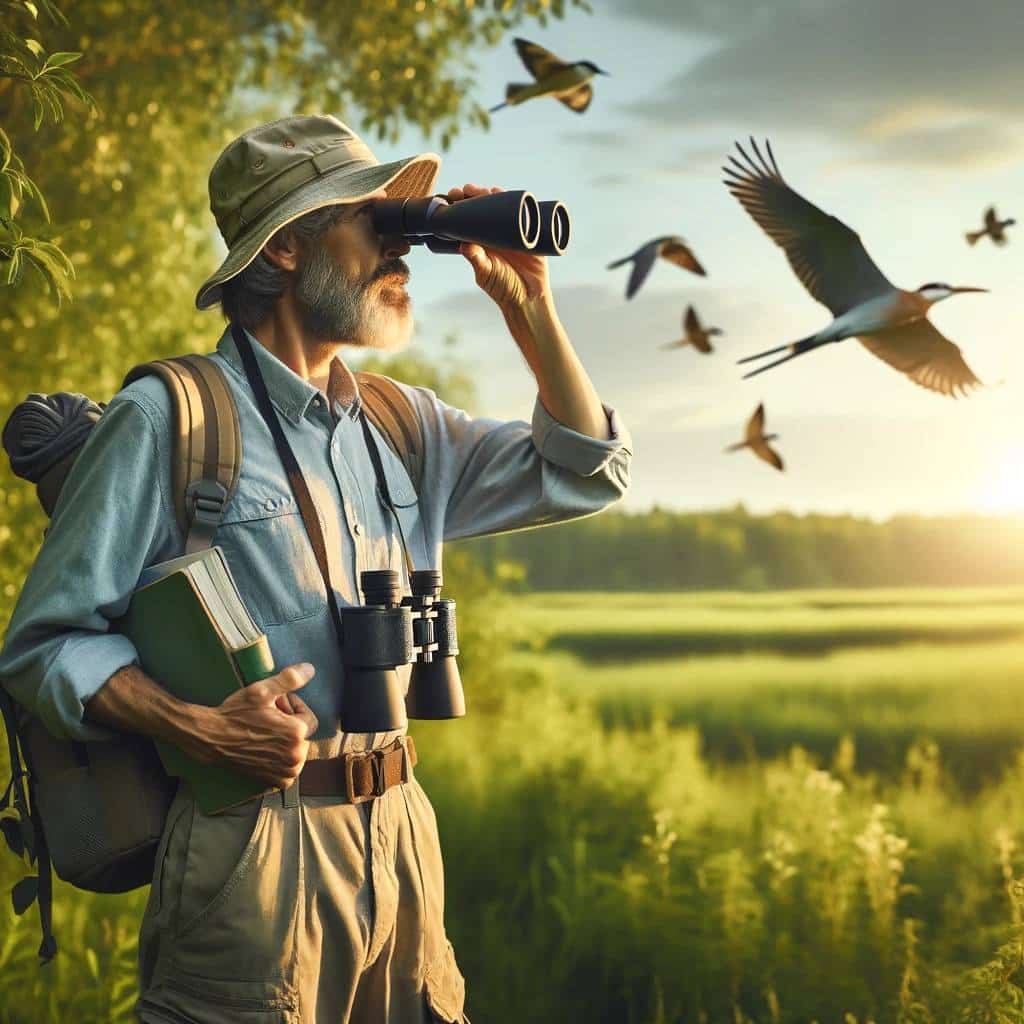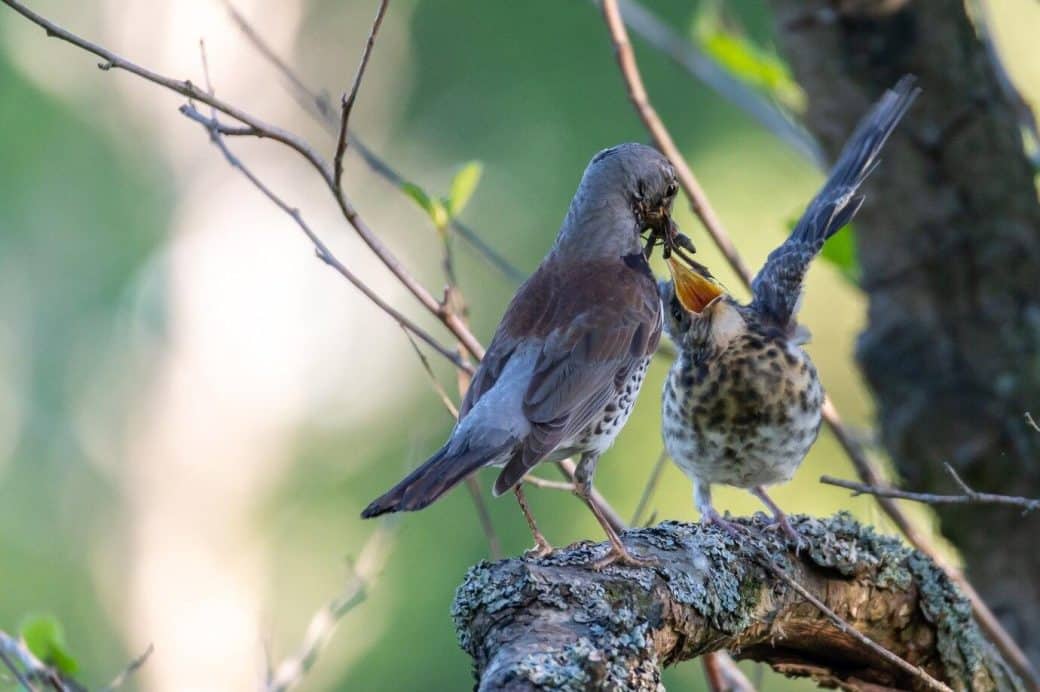Are you ready to step into the magical realm of birdwatching, where every flutter and chirp opens a new chapter of discovery?

Embarking on the journey through our “Birdwatching Glossary” opens the door to a world teeming with diverse bird species, from the familiar American birds to the exotic avians of North America and beyond.
So, grab your gear, and let’s embark on an adventure that promises endless wonders and surprises!
What is Birdwatching?
Birdwatching, or birding, is a fascinating hobby where enthusiasts observe or identify birds in their natural environment.
It’s not just about spotting different species; it’s an immersive experience that connects people with nature and enhances their knowledge of avian behavior, habitats, and conservation efforts.
Birdwatching can be done with the naked eye, through binoculars, or via listening for avian sounds, making it accessible to everyone from casual observers to dedicated ornithologists.
Uncommon Birdwatching Glossary
By understanding these specialized terms, you’ll unlock a new level of engagement with your avian adventures. Imagine deciphering the secret lives of birds, from their unique behaviors to their exotic habitats, and sharing these insights with fellow enthusiasts or curious friends.
This glossary is your gateway to becoming not just a birdwatcher but a true connoisseur of the avian world.
| Term | Description | |
| A | Accipitrine | About hawks and eagles, they are known for their keen hunting skills. |
| B | Brood Parasitism | An avian lays its eggs in the nests of other species, leaving them to raise its young. |
| C | Crepuscular | Avians active during twilight hours, at dawn and dusk. |
| D | Dimorphism | Differences in appearance between male and female birds of the same species. |
| E | Eyrie | A large nest of an eagle, falcon, or other avian of prey, typically built in a high, inaccessible place. |
| F | Fledge | The stage in a young bird’s life when it develops feathers and wing strength sufficient for flight. |
| G | Gape | The open mouth of a young avian, especially when begging for food. The size and shape of the gape can vary among different bird species, playing a crucial role in the parent’s ability to efficiently transfer food to the chick’s mouth. |
| H | Hyperphagia | An increase in eating behavior in birds preparing for migration or winter. Triggered by changes in daylight hours and temperature, signaling birds to consume more food than usual. The stored fat serves as an energy source during times when food is scarce and insulates against the cold. |
| I | Iridescence | A shimmering effect seen on the plumage of some avians, caused by the structure of the feathers.
This visual effect does not result from pigment but from the arrangement of feather structures and their interaction with light. Birds with iridescent plumage, such as hummingbirds, peacocks, and starlings, use this dynamic display for various purposes, including attracting mates, intimidating rivals, and camouflage. |
| J | Jizz | The overall impression or appearance of avian helps in its identification. |
| K | Kleptoparasitism | Stealing food or nesting material from other birds.
This behavior is common in seabirds like skuas and frigatebirds, but it’s also seen in other groups, including raptors and corvids. |
| L | Lekking | A behavior in which males congregate to engage in competitive displays to attract females. |
| M | Molt | The process of shedding and regrowing feathers. Some birds experience a complete molt once a year, while others may have a partial molt that only replaces certain feathers.
During molting, birds might appear scruffy or patchy and may reduce their activity levels or hide to avoid predators due to the temporary loss of flight capability or decreased insulation. |
| N | Nictitating Membrane | A transparent or translucent third eyelid present in some birds, offering protection and moisture. |
| O | Oology | The study of eggs, especially bird eggs.
By examining eggs, researchers can learn about the reproductive strategies of different species, variations in egg morphology related to environmental conditions, and parental investment. |
| P | Pelagic | Avians that live on the open ocean, far from land. They come to land only to breed and nest, typically on remote islands where they are less vulnerable to predators.
Some pelagic birds are known for their remarkable long-distance migrations, crossing thousands of miles of open water to reach breeding sites or seasonal feeding grounds. |
| Q | Querulous | Describing a plaintive or complaining bird call. These sounds can vary significantly between species but generally convey agitation, distress, or discomfort. |
| R | Rictal Bristles | Stiff, hair-like feathers around the base of the beak in some avians. |
| S | Supercilium | A stripe running from the base of the bird’s beak above its eye to the back of its head, often in a contrasting color. |
| T | Torpor | Avian enters a low-activity state with cooler body temperatures to save energy.
This temporary hibernation-like condition can last from a few hours to several days, depending on environmental conditions and the species’ needs. Birds in torpor become less responsive to external stimuli and reduce their physical activity to minimal levels, which is crucial for survival in harsh conditions. |
| U | Undertail Coverts | Feathers located beneath the tail of avian are often used in identification.
These feathers can vary in color and size among species, offering clues to the bird |
| V | Vagrant | Avian that appears outside its expected geographic range.
Vagrancy in birds is a phenomenon that can lead to the temporary or occasional presence of an individual from a species in an area where it is not commonly found. |
| W | Wattle | A fleshy caruncle or protuberance on the head or neck of certain avian.
This feature serves various functions, including thermoregulation, as blood flow to the wattle can help control body temperature. Additionally, wattles play a significant role in sexual selection and communication among avians. |
| X | Xanthochroism | An unusual yellow pigmentation in a bird’s plumage. |
| Y | Yaffle | An old English name for the green woodpecker, inspired by its call. |
| Z | Zygodactyl | Having two toes pointing forward and two backward, a common trait among woodpeckers and other climbing birds. |

You can watch here for more details about birdwatching:
Conclusion
Observing birds provides a delightful gateway to the wonders of the natural world. Armed with just binoculars and a guidebook, anyone can embark on a journey to spot and learn about a myriad of bird species.
This hobby not only allows us to marvel at the aesthetic splendor of birds but also imparts crucial lessons on the stewardship of their habitats. So, let’s gear up and dive into the fascinating realm of birds that surround us, contributing our part to safeguard nature for all.

